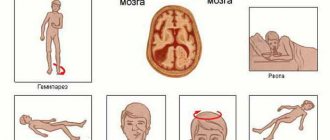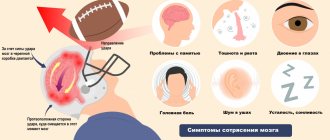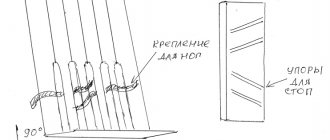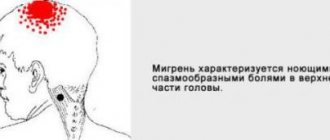Severity of injury
In order for the provision of assistance to the victim to really have the desired effect, experts recommend conducting at least a cursory initial examination before starting pre-medical procedures. This will allow you to determine the approximate severity of the head injury.
The easiest way to cope is with a mild degree of the disease, which is more typical of accidental household injuries such as hitting your head on the edge of a cabinet. The deviation is not accompanied by any heavy bleeding and does not bring any particular discomfort during recovery. Typically, such mild bruises are limited to the formation of a small swelling, which is popularly called a “bump.”
It goes away on its own, but sometimes, to speed up the process, it is allowed to apply cold immediately after the blow. This will somewhat reduce pain and also limit the spread of swelling.
The situation with damage to the integrity of the skin is a little more complicated. The category includes not only extensive wounds that occur when a large area of skin along with hair is combed. Even ordinary abrasions provoke an outflow of blood. But only in the first case the patient has to deal with a large amount of blood, and in the second case only capillary bleeding is stopped.
If emergency measures are taken, it will be possible to block capillary breaks to stop bleeding within 5-10 minutes.
Three other categories are considered separately:
- jaw damage;
- traumatic brain injury;
- combined options.
Complex pathologies are more suitable for describing polytrauma, when, in addition to deformation of the head, destabilization of the spine or any other part of the body is simultaneously recorded. This format is most often found in road accidents, fights and industrial injuries, when there is damage to the chest and limbs.
A particularly serious development of events is a related deviation in the issue of the integrity of the neck systems. We are talking about the rupture of nerve endings and large vessels designed to nourish the brain.
Almost always, a head blow is accompanied by minor, but still skin injuries. In addition to the immediate top layer, the natural integrity of the fatty tissue is disrupted. Because of this, blood flow through the affected vessels is obstructed. The clinical picture ends with the collection of blood at the site of localization, which externally transforms into a hematoma of various sizes.
Depending on the severity and duration of the blow, the color of the hematoma changes. If initially it turns purple due to fresh blood stains under the skin, then later the tone changes. The transformation is due to the launch of the process of hemoglobin breakdown and increased activity of leukocytes. Externally, such manifestations are expressed in a change in color to blue-green with yellowness.
The swampy tint is provided by biliverdin, and bilirubin is responsible for imparting yellowness.
If there is strong external pressure during a mechanical injury, it is often accompanied by destabilization of the tendon helmet. Doctors recognize such a deviation due to a hematoma, which seems to be spreading across the face.
When a victim falls on their face, they have to deal with soft tissue damage. There is one pitfall here that ordinary people do not know about. Some people unknowingly confuse the outer rim of a hemorrhage with a depressed cranial fracture.
Diagnosis and treatment of TBI
In addition to external signs, traumatic brain injuries are diagnosed using special neurological tests, electroencephalography and tomography (MRI or CT).
Treatment of TBI is divided into two stages:
- acute: relief of symptoms accompanying the injury itself (surgery may be required);
- rehabilitation: includes medication-assisted recovery after injury and rehabilitation of lost functions due to severe brain damage.
Alas, most mild TBIs remain undiagnosed, since people usually believe that a slight blow to the head has no consequences, and periodic headaches, memory loss and other neurological disorders are in no way associated with such microtraumas. However, common consequences of TBI include:
- impaired coordination of movements, gait, dysfunction of the upper limbs,
- sleep disturbances, fatigue,
- causeless anxiety, apathy, irritability,
- disturbances of attention and memory, decreased mental abilities,
- disturbances in the functioning of the sense organs (vision, hearing, tactile sensitivity),
- medical complications: acquired epilepsy, edema or dropsy of the brain, etc.
If you have had cases of head injury and periodically notice the signs of TBI listed above, you should visit a consultation with a neurologist. Even minor injuries can eventually manifest into unpleasant complications that reduce a person’s quality of life.
Specific symptoms
All symptoms accompanying any type of head injury are expressed differently depending on the specific location of the lesion. If we are talking about the facial part, when the usual integrity of the skin is broken and deep tissues are affected, then the first dangerous sign is pain. The syndrome is reinforced by hemorrhage. After a while, a bruise appears on the face.
If serious damage to the skull is recorded, the victim is faced with the same phenomena that can be observed with a cerebral contusion:
- nose bleed;
- dizziness;
- headache;
- vomit.
In such a scenario, medical care should be provided immediately, before irreversible processes begin.
With occipital lesions, patients often complain of the inability to focus their eyes and other vision problems. This is explained by the anatomical features of the human body, because it is in the back of the head that the center responsible for visual functions is located.
In this situation, concussions and general weakness are not uncommon, which often becomes the basis for frequent fainting.
An eye injury is marked by a circular hemorrhage. But not everyone knows how to distinguish it from the so-called glasses effect. The latter is suitable to describe the condition of a cranial fracture.
Those whose jaws are injured will need emergency medical care. Here, the first step is to check the chewing function. If, during a light test, it turns out that a person is not able to make the usual chewing movement, then this indicates a fracture.
The condition of children who have been victims of head injuries should be checked especially carefully. In children, all types of presented deviations may not manifest themselves at first, but in adolescence or even adulthood they may result in serious deviations in brain activity.
Clinical features of head injuries
All head injuries can be divided into several broad categories according to a standard principle, as is typical for sorting injuries to the abdomen or chest.
Schematically, the classification is divided into three divisions:
- closed;
- open;
- penetrating.
The first point implies the absence of destabilization of the aponeurosis. Instead, there are bruises of various locations and sizes, as well as other versions of soft tissue rupture.
With open analogues, the emphasis is on damage to the aponeurosis. But the worst situation is with penetrating wounds, when in addition to destruction of the integrity of the surface and subcutaneous tissue with vessels and nerve roots, damage to the dura mater is noted. It is these variations that harm the patient the most.
In addition to the typical classification by mechanism of injury, the medical classification has another structured sorting. It is based on clinical manifestations, including:
- brain concussion;
- bruises;
- compression by intracranial hematomas.
Classic concussion occurs in approximately 80% of all recorded cases of damage to the head of the body. It is characterized by the absence of macrostructural pathology, which is explained by the presence of damage only at the cellular level. Physiologically, a concussion can be designated a functionally reversible pathology.
Specific manifestations of this condition are called:
- being unconscious for up to several minutes;
- nausea;
- vomiting;
- amnesia;
- dizziness;
- spreading headache;
- increased sweating;
- double vision.
At the same time, vital functions remain normal. But neurological abnormalities, even in minor manifestations, are still diagnosed. They cover:
- asymmetry of tendon reflexes;
- small-scale nystagmus.
All of the above goes away over the next week with fairly effective therapy. But in order to ensure that there are no more significant consequences, the victim will be required to undergo additional examination. This includes the need to provide images obtained during a CT scan or magnetic resonance therapy.
No less often, patients are found with intracranial hematomas, which, as they grow, begin to compress still healthy tissue. Bruises form under or above the dura mater. The cause of the disease is depressed fractures of the cranial bones.
Despite the fact that their clinical manifestations are similar to those of a brain contusion, they still have their own distinctive features. The main sign of this is the so-called “light gap”.
Doctors call this the time interval between waking up after fainting and a sharp plunge into a coma. At this time, the person feels relief, but in fact, cerebral edema begins to rapidly progress.
Brain contusions
Lesions such as bruises of the brain itself are considered separately. They are divided into three degrees of severity, which are distinguished by gross macrostructural damage to the brain matter.
This manifests itself as hemorrhage and destruction.
There is no bruise without subarachnoid hemorrhage. Fractures of the skull bones are frequent accompaniments of the presented injuries. They are accompanied by significant edema with swelling of the brain substance.
If the patient, after direct external influence on the skull, remained unconscious for no more than twenty minutes, then this indicates a mild version of the development of events. After waking up, victims begin to complain of endless dizziness, which is complemented by nausea and vomiting.
Such patients have retrograde or anterograde amnesia. Against the background of stable vital functions, disruption of the usual activity of the cardiovascular system looks more depressing. We are talking about bradycardia or hypertension.
On the neurological side, experts note pyramidal insufficiency, clonic nystagmus and mild anisocoria.
With moderate severity, disconnection from reality can last about two hours. Almost immediately after waking up, a person begins to experience repeated vomiting. Additionally, pronounced amnesia manifests itself, and even some deviations in mental health.
Vital disturbances are expressed in prolonged bradycardia, which is supported by hypertension along with tachypnea. But the airways remain normal, which reduces the risks of more serious diseases.
The neurological status may include all those signs that are characteristic of a mild course of the disease, and may also be diluted by the asymmetry of tendon reflexes with muscle tone.
In some cases, meningeal symptoms and pathological traces make themselves felt. Among other things, focal types of destabilization such as pupillary, oculomotor, speech disorders, as well as paresis of the limbs are occasionally possible.
Severe degree is characterized by a long duration. A person may remain in a coma for several weeks, while his vital functions are seriously impaired, posing an increased threat to life.
The most pronounced alarming symptoms are brainstem symptoms, which include floating movements of the eyeballs, destabilization of the rhythm and frequency of breathing. Paresis of the limbs, convulsive seizures, and pathological foot signs are diagnosed.
The longer the coma lasts, the less favorable the prognosis for later life becomes. The reason for this is the large affected areas. Including disruption of the bone structures of the head, as well as massive subarachnoid hemorrhages.
If you do not see a doctor in time after an injury, the consequences for a person can be quite unpleasant: decreased or loss of memory, impaired attention, difficulty doing household chores, emotional distress, etc.
Symptoms of traumatic brain injury
For head injuries, individual symptoms or the entire symptom complex may be recorded (depending on the severity of the injury):
- headache
- dizziness
- nausea and vomiting
- loss of consciousness
- clouding and confusion
- tinnitus
- hallucinations, delusions
- amnesia (partial or complete)
- bleeding from the nose or ears
- abrasions, head contusions, swelling and hematomas, open fractures
- neck muscle tension
- with fractures of the neck and base of the skull, cerebrospinal fluid (CSF) may leak through the ears








